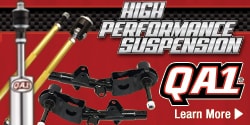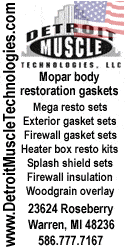I've been following this thread like a mystery novel. I just thought of a wild possibility as "chain jumped" was the first thing to come to my mind like several others. Is it possible the balancer has slipped and TDC with rotor on #1 is just occurring due to luck even though the chain has jumped? Do you know if the TDC mark was correct before the fail to start? I've had 2 small-block Chryslers over the years that the chain died the same way. Ran fine when shut off and then jumped chain.
Need help ?
- Thread starter Benjamin F Cothran
- Start date
-
4eighteener
Well-Known Member
BTW, dielectric grease is also non-conductiveActually, you should never use vaseline on electrical contacts, vaseline is an insulator, not a conductor, it does NOT conduct electricity, it actually prevents the flow of electricity. Instead, you should be using dielectric grease, it both helps prevent corrosion, AND allows electricity to flow freely.
I used vaseline for years too, until I got schooled. Look it up if you dont believe me
4eighteener
Well-Known Member
No one is asking the important question,
"Whatcha gotta have for that car?"
"Whatcha gotta have for that car?"
So maybe it's remotely possible you left the key on and burned the points up.
Or since he hasn't had the car that long wonder if it has the wrong timing cover or dampner....I've been following this thread like a mystery novel. I just thought of a wild possibility as "chain jumped" was the first thing to come to my mind like several others. Is it possible the balancer has slipped and TDC with rotor on #1 is just occurring due to luck even though the chain has jumped? Do you know if the TDC mark was correct before the fail to start? I've had 2 small-block Chryslers over the years that the chain died the same way. Ran fine when shut off and then jumped chain.
Cause 60psi is lowwwew
Oh yes your right thought he said it was new to him
I sticking to a skipped chain
I sticking to a skipped chain
MechNerd
I can fix stupid, but it's gonna hurt...
If I lived anywhere near you I would drive over and give you a hand. Is there any member that lives close enough to help?
Maybe pull a valve cover and watch the #1 valves as it's brought up to compression stroke? Even if it only jumped one tooth, there should be backfiring/ popping, or maybe flames out the carb. Something to show it's burning fuel somewhere.
Right now it's anybody guess.
Maybe pull a valve cover and watch the #1 valves as it's brought up to compression stroke? Even if it only jumped one tooth, there should be backfiring/ popping, or maybe flames out the carb. Something to show it's burning fuel somewhere.
Right now it's anybody guess.
60 psi...that's a couple of teeth
Think it tow time
Dont think he's doing a chain in his driveway
Think it tow time
Dont think he's doing a chain in his driveway
@Garrett Ellison is this feller anywhere near you?It was 3 or 4 pumps to get it up to 60 ish . I have turned the crank shaft to TDC and the rotor points to the #1 position , front left side of the engine .
18mm hole in the block? I hope you're talking spark plug holes. And in a small block they would be 14mm...I tried the starting fluid and the engine did NOT fire up ? My Dad was a diesel mechanic . I have his tool box . I remember seeing some large dial gauges . Maybe one will fit the 18 m/m hole in my block ?
Found my Dad's compression gauge . I removed all the plugs and held the gauge firmly against the spark plug hole in each position . Used the remote starter to compress each hole . It averaged around " 60 " between the 8 plug holes .
View attachment 1716386485
Dis something escape from the block that wasn't supposed to?
Daing! Just a little too far upstate... Otherwise, we'd be right there!@Garrett Ellison is this feller anywhere near you?
That figgers. It was a thought anyway. Thanks buddy.Daing! Just a little too far upstate... Otherwise, we'd be right there!
Just as a check, put the engine at TDC #1 and pull the distributor and see if the slot in the oil pump drive lines up with the drivers side intake manifold front bolt. IF (Yes, unfortunately, the biggest two letter word in the English Language!) the engine hasn't been apart before, it may show a jumped timing chain.
LA Engine Build - Where / How to Line up the Dist / Oil Pump Drive gear?
LA Engine Build - Where / How to Line up the Dist / Oil Pump Drive gear?
It's been a while since I've been to Richmond. It'd about be worth it just to check out those two rides!
Dave999
Well-Known Member
went through similar worriesActually, you should never use vaseline on electrical contacts, vaseline is an insulator, not a conductor, it does NOT conduct electricity, it actually prevents the flow of electricity. Instead, you should be using dielectric grease, it both helps prevent corrosion, AND allows electricity to flow freely.
I used vaseline for years too, until I got schooled. Look it up if you dont believe me
vaseline so thin that the pressure of the connector connecting smears it off the contact parts leaving just the exposed bits covered, if the connector is good the pressure between the parts should keep the "connected" bit reasonably good for a year or two but corrosion creeps in, but with a smear of vas... it is also surrounded by an air and moisture proof dam.....
but i worried so i tried copper-slip ..don't try it..... what a mess corrodes to a green jelly..... never again....
i tried graphite paste.... just shorts everything out a makes a mess
3 in one oil works but gets everywhere... better than nothing but only just...
wheel bearing grease is a bit thick....
in theory if spotless i.e the connectors were new you could spray the lot with a light varnish whilst apart, let it dry then connect and disconnect until contact is made..... luck of the draw and a pain in the butt.....
thus went my thinking.... you now have far too much insight into what goes on in my head....! 95% idiocy and the occasional 5% of well that kinda works...
i'll stick with the vaseline
but of course i introduced another little fire risk...its a low low risk but i did, but hey the insulation and the plastic connector will burn just as nicely.
the smell of hot vaseline...early warning system... then again my ammeter is connected (standard alternator standard OEM wiring) and always has been.... i live on the edge
Dave
Last edited:
I know this doesn't help the OP, but I can't get over how awesome it is that he bought that Barracuda and D100 both brand new and still have both in that condition. Kudos to you, Mr. Cothran.It's been a while since I've been to Richmond. It'd about be worth it just to check out those two rides!
NO doubt!I know this doesn't help the OP, but I can't get over how awesome it is that he bought that Barracuda and D100 both brand new and still have both in that condition. Kudos to you, Mr. Cothran.
Benjamin F Cothran
Active Member
Describe the process you are using to start the car.
Like...
Pump gas 2 times, turn key to start, engine cranks over but doesn't start.
2 more pumps and turn key to crank etc.
You need to do some more sleuthing
Get a helper
With key off measure voltage at the ignition side of the ballast and the dust side of the ballast. You should have 0 volts.
With the key in the run position measure the same points. You should have 12v (battery voltage) to the ignition side of the ballast and 7 to 11 volts on the coil side of the ballast
Remove the yellow wire from the starter relay.
With the key in the start position measure the same points. You should have 12v (battery voltage) to the ignition side of the ballast and 12v (battery voltage) on the coil side of the ballast.
And report back your findings.
This problem is a process. You shotgunned all the parts but still have the problem.
So now let's go through the systems one at a time verifying their function.
Gave up on my volt meter . I have another option which is a dash mount volt meter . See photo .
Volt meter reads 13 v yesterday until I did all that cranking on the engine to check compression . This morning it reads 12 v . So , I will try to answer your questions above :
With key off , both sides of the ballast resistor has no voltage .
With key on , I have 10.5 v on the engine side and barely moving the needle on my volt meter on the outside .
Remove the yellow wire from starter relay and key on , I get 10.5 v on the engine side and barely moving on the outside .
Last edited:
Benjamin F Cothran
Active Member
Truck was painted original light blue a few years ago . Never wrecked , but had some rust problems over rear wheel wells & left rocker panel that were welded up .NO doubt!
Barracuda was painted original " mauve " color many years ago . Now has some rust problems thar need fixing . Never wrecked .
Only two vehicles I have ever bought .
ragtopfury
Well-Known Member
I'm kinda with the folks who suggest the timing chain has jumped a tooth or 2.
Or your points/condenser are messed up.
Odd thought here that I seem to remember having an issue with about 30 years ago..... One of my mopars back then had that condenser looking thing at the distributor that was supposed to suppress ignition noise to the radio. That thing went bad and the car would not start. Removed it and all was good.
Or your points/condenser are messed up.
Odd thought here that I seem to remember having an issue with about 30 years ago..... One of my mopars back then had that condenser looking thing at the distributor that was supposed to suppress ignition noise to the radio. That thing went bad and the car would not start. Removed it and all was good.
Benjamin F Cothran
Active Member
I replaced the points & condenser inside of the distributer after it would not start the next morning .
Could the chain jump the next morning while it was running fine when I cut it off the night before ???????????
Engine was rebuilt in 1995 by Little & Jenkins in Roanoke Rapids , North Carolina . A major engine rebuilder for the east coast . Left the car and they removed my engine , rebuilt it to factory specs and I picked it up about a week later once finished .
Could the chain jump the next morning while it was running fine when I cut it off the night before ???????????
Engine was rebuilt in 1995 by Little & Jenkins in Roanoke Rapids , North Carolina . A major engine rebuilder for the east coast . Left the car and they removed my engine , rebuilt it to factory specs and I picked it up about a week later once finished .
That is how I've had the chain die twice. I don't know why, just that it's not that uncommon.I replaced the points & condenser inside of the distributer after it would not start the next morning .
Could the chain jump the next morning while it was running fine when I cut it off the night before ???????????
Engine was rebuilt in 1995 by Little & Jenkins in Roanoke Rapids , North Carolina . A major engine rebuilder for the east coast . Left the car and they removed my engine , rebuilt it to factory specs and I picked it up about a week later once finished .
jeff alder
Well-Known Member
The chain could have jumped time during coast down when the key was last turned off. The bottom line is if you see spark at the gap and there is no fuel on the plugs the engine will not start. It would probably still try to start even with improper timing but correct timing would certainly be a plus.
furrystump
Well-Known Member
- Joined
- Nov 13, 2004
- Messages
- 2,430
- Reaction score
- 2,094
It could have kicked back very slightly the last time you shut it down.
-
















